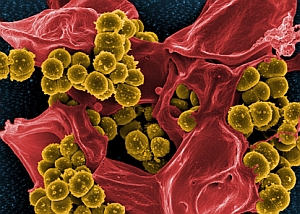9 April 2014. Researchers in the U.K., U.S., Sweden, and Turkey developed a technique based on genomic sequencing to predict the pathogenic severity of methicillin resistant Staphylococcus aureus or MRSA bacteria, an antibiotic-resistant microbe often found in health care facilities. The team led by University of Bath biologist Ruth Massey published its findings today online in the journal Genome Research.
The Centers for Disease Control and Prevention says the number of cases of MRSA infections are declining in U.S. hospitals and clinics, but remains a serious problem. A CDC study published last year in the American Medical Association’s journal Internal Medicine reports life-threatening MRSA infections declined by more than half (54%) between 2005 and 2011. The same study reported nearly 31,000 fewer MRSA infections from 2005 to 2011, with 9,000 fewer hospital deaths.
Nonetheless, the study reported more than 80,000 cases of life-threatening MRSA infections in 2011, with more than three-quarters of these cases (78%) diagnosed either while in the hospital or soon after release. A 2007 study estimated the direct economic burden on hospitals of MRSA infections between 1999 and 2005 at more than $6 billion, which does not include indirect costs related to patient pain, illness, and time spent in the hospital.
The MRSA microbe is a complex organism, which the authors note, may require a more sophisticated and nuanced response than many current approaches. Massey and colleagues sequenced the genomes of 90 pure MRSA cultures and identified 125 genetic mutations that made each culture either high or low in toxicity.
The team was then able to find a common genetic signature for the high-toxicity cultures. Knowing this signature, say the authors, makes it possible to predict the cultures most likely to be toxic and cause severe cases of MRSA infection.
These findings, says Massey, make it possible to develop a diagnostic technique based on sequencing a swab sample from the patient and personalized to the individual’s infection. “Clinicians will then be able to tailor the treatment to the specific infection,” notes Massey in a university statement. “This technique can tell them which combination of antibiotics will be most effective, or tell them which drugs to administer to dampen the toxicity of the infection.”
The university says the researchers are extending this technique to other virulent MRSA strains as well as other bacterial pathogens.
Read more:
- Faster Process Developed to Test for Staph Infections
- Synthetic Bio Platform Finds Potential Superbug Antibiotic
- Clinical Trial to Test Safety of MRSA Drug Candidate
- Challenge Seeks Point-of-Care Staph Bacteria Detector
- Intensive Care Units in U.K. Cut Blood Infection Rates
* * *


 RSS - Posts
RSS - Posts
You must be logged in to post a comment.